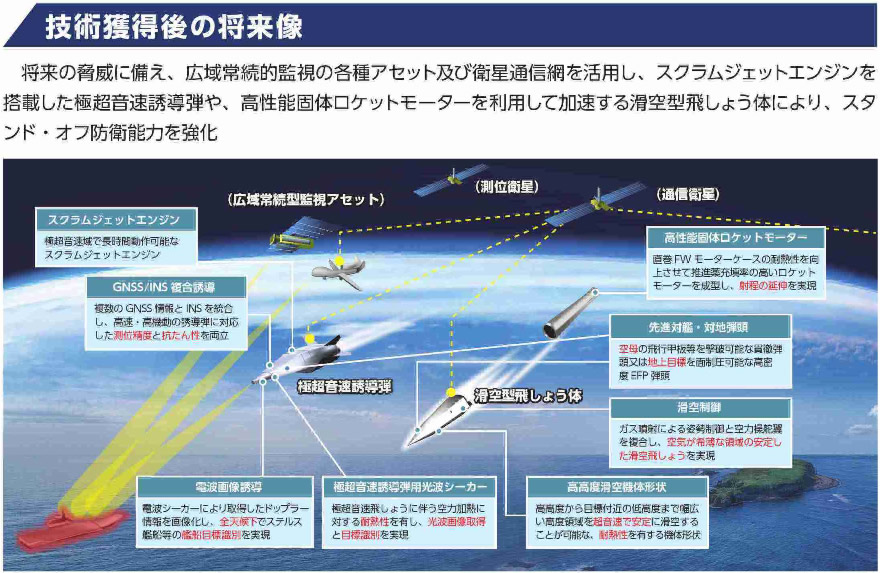島嶼防衛用高速滑空弾の事前発射試験
As the security environment surrounding Japan becomes increasingly severe, including Russia's invasion of Ukraine and China's ballistic missile launches around Taiwan, we filmed Japan's only short-range missile firing range for the first time on TV.
Summary
This document contains two articles about Japan's development of a new weapon called the Hyper Velocity Gliding Projectile (HVGP). Here are the key points:
1. The HVGP is being developed by Japan for island defense roles, with deployment scheduled to begin in fiscal year 2026.
2. It's a hypersonic weapon launched from a truck-mounted system, with an estimated range of about 900 km for the initial version.
3. A test launch was conducted on March 23, 2024, in California, USA, to verify measurement systems for future tests.
4. Development began in fiscal year 2018, but due to increasing threats from China and North Korea, early mass production started in fiscal year 2023.
5. The HVGP is being developed in phases:
- Block 1: Early Deployment Version (basic version)
- Block 2A: Enhanced Capability Version with a range up to 2,000 km
- Block 2B: Further enhanced version with a range of 3,000 km
6. Future versions may include anti-ship capabilities, potentially able to target aircraft carriers.
7. The weapon is designed to be difficult to detect and intercept due to its small radar cross-section and unpredictable flight path.
8. Japan is considering the possibility of international joint development, potentially with the United States.
9. The HVGP is part of Japan's strategy to defend against potential military invasions of its remote islands, including the Senkaku Islands.
10. The development of this weapon is in response to the increasingly severe security environment surrounding Japan, including threats from China and North Korea.
Video: Japan tests Hyper Velocity Gliding Projectile - HVGP - Naval News
Screen capture from ATLA video showing the test launch of HVGP.
The HVGP is a new weapon scheduled to be deployed by the Japan Ground Self-Defense Force (JGSDF) starting in the fiscal year 2026. The hypersonic weapon is being developed for “island defense” roles. After being launched by a booster from a truck-mounted launcher, the warhead separates and glides to attack its target. The estimated range is approximately 900 km.
The footage shows a test which was conducted on March 23, 2024, in California, USA. According to ATLA, the purpose was “to verify the measurement systems for future launch tests.”
Research and development on the HVGP began in the fiscal year 2018, with the goal of completing development by the fiscal year 2025. However, due to the increasing military threats from China and North Korea, early mass production started in the fiscal year 2023 without waiting for the completion of development. The manufacturing is being handled by Mitsubishi Heavy Industries (MHI).
To achieve early deployment, the HVGP is planned to be developed in incremental capability enhancements. The test conducted this time was for the most basic “Early Deployment Version (Block 1)” test projectile. Furthermore, the development of an “Enhanced Capability Version (Block 2A)” with a significantly extended range capable of attacking targets up to 2,000 km away, and an “Enhanced Capability Version (Block 2B)” with a range of 3,000 km, is scheduled to be completed in the fiscal years 2027 and 2030, respectively.
Here is the video released by ATLA:
Here is the English translation of the video description:
Recently,
we conducted a launch test of a Hyper Velocity Gliding Projectile for
island defense among the domestically produced stand-off missiles and
confirmed the measurement system.
As previously reported by Naval News, Japan’s HVGP (速滑空弾) could eventually have an anti-ship capability and be used against aircraft carriers. This consideration is part of the research on future enhanced capability versions. In the future, it is possible that the warhead could be equipped with a seeker for use in anti-ship mission.
Yoshihiro Inaba is a Freelance Writer based in Shizuoka, Japan. He is one of the few young military writers in Japan and is currently a student studying international law (especially self-defense and use of force) at a Japanese graduate school. He is particularly familiar with Japan's Ground, Maritime and Air Self-Defense Forces.
Japan to develop and deploy Supersonic Glide Weapons that can target ships - Naval News
Artist impression of a Hypervelocity glide weapon
Japan is preparing against a potential military invasion of its remote islands located in the East China Sea, including the Senkaku Islands. The HVGP is a new solution to defend against such invasion attempts.
The HVGP is launched from a mobile ground launcher. Once it reaches a certain altitude, the glider separates from the booster, and then glides at high altitudes at supersonic speeds while being guided by both satellites and inertial navigation system (INS). It then flies to the target point. The target is attacked from directly above at a 90° dive.
When the HVGP is separated from the booster, the warhead’s Radar Cross-Section (RCS) becomes extremely small, making it difficult to detect with radar. In addition, it will fly at high altitudes at supersonic speeds while following unpredictable trajectories, including high dives, thereby shortening the reaction time and making it difficult for enemy air defense systems to intercept.
Japan’s HVGP Block 1 and Block 2

The HVGP is planned to be developed and deployed in two phases (Block 1& Block 2) in order to achieve a short-term deployment:
- Block 1 is an early capability version. Its development period will be shortened by using existing missile technologies and by conducting tests of prototype with JGSDF unit.
- Block 2 is an enhanced capability version that makes use of the latest technology, which Japan’s Acquisition, Technology & Logistics Agency (ATLA) calls a “game changer”.
In HVGP Block 2, the warhead glides with the shape of a “wave-rider” that gains lift by the shock wave generated at the tip of the warhead. Due to this unique warhead shape, the range of Block 2 will be longer than that of Block 1.
U.S. Army LRHW

The U.S. Army is currently developing a Long Range Hypersonic Weapon (LRHW), a weapon similar to the HVGP, with the prototype expected to be scheduled for completion in fiscal year 2023. The development of the HVGP, especially Block 2, is expected to have technical and budgetary challenges, so the possibility of joint development between Japan and the United States is undeniable. In fact, the Japanese MOD’s official document on the HVGP states that development considerations will be made “with the possibility of international joint development”.
HVGP in anti-ship role

Interestingly, at a symposium held by ATLA in Tokyo late last year, an image of HVGP Block 2 attacking enemy aircraft carriers was released. In other words, it is planned that the Block 2 warhead will be equipped with a seeker to attack moving targets. Target acquisition of distant enemies and transmission of the targeting data to the HVGP is a challenge for now, but JSDF is currently working on establishing an information sharing system to conduct joint anti-ship warfare.Therefore, target information captured by the Japan Maritime Self-Defense Force (JMSDF) patrol aircraft and the Japan Air Self-Defense Force (JASDF) F-35 is expected to be used through data links.
According to a report by the Japanese newspaper Mainichi Shimbun on February 25, 2020, the range of the HVGP is about 500 km, but this is not an official figure, so the actual range is still unknown. However, logically, increasing the fuel capacity of the rocket to launch the HVGP will naturally extend the range of the warhead. Japan is currently under threat of ballistic missiles from North Korea and various types of missiles from China, and the HVGP may be a new solution to preemptively (before their launch) eliminate those threats from a safe distance.
Update 04/04/2020: Naval News an exclusive video from ATLA, the Acquisition, Technology & Logistics Agency of the Japanese M.O.D, showing the HVGP in an anti-ship role, targeting an aircraft carrier:
Yoshihiro Inaba is a Freelance Writer based in Shizuoka, Japan. He is one of the few young military writers in Japan and is currently a student studying international law (especially self-defense and use of force) at a Japanese graduate school. He is particularly familiar with Japan's Ground, Maritime and Air Self-Defense Forces.





No comments:
Post a Comment